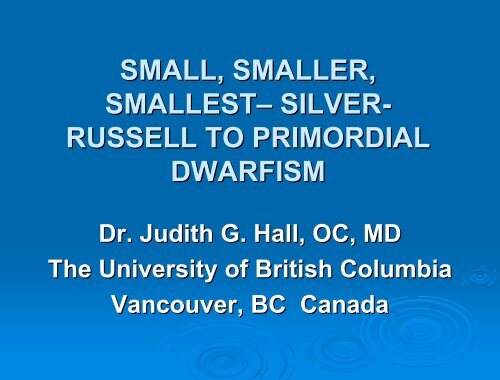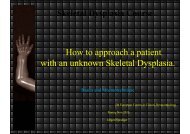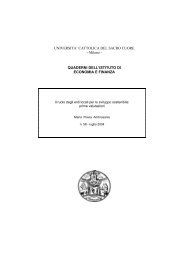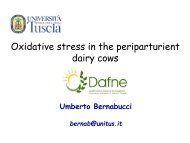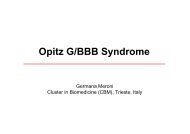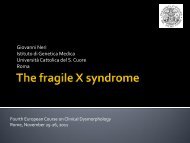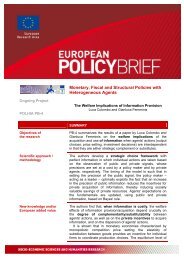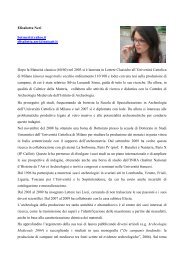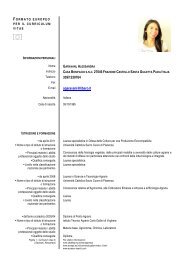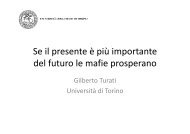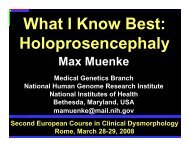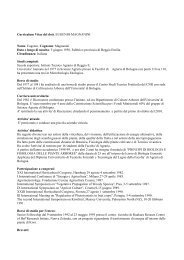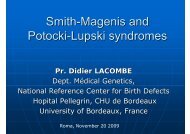SHORT syndrome
SHORT syndrome
SHORT syndrome
Create successful ePaper yourself
Turn your PDF publications into a flip-book with our unique Google optimized e-Paper software.
SMALL, SMALLER,<br />
SMALLEST– SMALLEST SILVER- SILVER<br />
RUSSELL TO PRIMORDIAL<br />
DWARFISM<br />
Dr. Judith G. Hall, OC, MD<br />
The University of British Columbia<br />
Vancouver, BC Canada
CAUSES OF GROWTH<br />
RESTRICTION<br />
Bone disorders - chonrdrodysplasias, chonrdrodysplasias,<br />
rickets<br />
Nutritional - chronic infection, Celiac disease,<br />
Crohn’s Crohn disease, malabsorption<br />
Congenital anomalies - cardiac, renal, CNS<br />
Metabolic - renal acidosis, glycogen storage<br />
disease, etc.<br />
Emotional - psychosocial dwarfism<br />
Endocrine - hypothyroidism, hypopituitarism,<br />
hypopituitarism,<br />
Cushing’s Cushing s disease<br />
Intrauterine growth retardation - Turner <strong>syndrome</strong>,<br />
small for dates, many <strong>syndrome</strong>s, infection,<br />
chromosomal anomalies<br />
Normal variation - familial short stature,<br />
constitutional delay
HOW TO APPROACH <strong>SHORT</strong><br />
STATURE?<br />
1. Present at birth vs. later onset (i.e.,<br />
IUGR, SGA, primordial)<br />
2. Proportionate vs. non-proportionate<br />
non proportionate –<br />
relative to what?<br />
3. How short is short?<br />
4. When falls off centiles in utero<br />
5. Growth pattern after birth
IUGR – Intrauterine Growth Retardation<br />
SGA – Small for Gestational Age<br />
PRIMORDIAL – Prior to Birth<br />
IUGR = SGA = PRIMORDIAL<br />
Below the 3 rd centile for gestational age<br />
How far below?<br />
Relative centiles of OFC, length, and<br />
weight
NATURE’S NATURE S RULE OF THUMB<br />
OFC > LENGTH > WEIGHT<br />
i.e., Preserve the brain if you<br />
can
RELATIVE TO WHAT AT WHAT AGE?<br />
OFC, length/height, weight<br />
FOR AGE (and to each other)<br />
OFC, length/height, weight<br />
FOR HEIGHT AGE<br />
OFC, length/height, weight<br />
FOR BONE AGE
PROPORTIONAL VS. NON-PROPORTIONATE<br />
NON PROPORTIONATE<br />
(MIDGET) (DWARF)<br />
Length/height compared to span<br />
Upper/lower segment<br />
Proximal, middle, distal
HERE WE ARE TALKING<br />
ABOUT:<br />
IUGR/SGA (prenatal)<br />
Relatively proportionate short<br />
stature postnatally<br />
Very, very small types of <strong>syndrome</strong>s<br />
Centiles have little meaning way, way,<br />
way, below 3 rd centile! centile<br />
>>>3 rd centile
Significant IUGR<br />
Relatively PROPORTIONATE/POST NATAL<br />
<strong>SHORT</strong> STATURE DISORDERS<br />
1. Bloom*<br />
2. Dubowitz<br />
3. Floating Harbor<br />
4. MOPD II*<br />
5. Mulibrey* Mulibrey<br />
6. Silver-Russell/Russell<br />
Silver Russell/Russell-Silver*** Silver***<br />
7. <strong>SHORT</strong><br />
8. 3-M* M*<br />
Also: Chromosomal, CPM, and teratogens
A<br />
B<br />
C<br />
FLOATING<br />
HARBOR<br />
MULIBREY<br />
DUBOWITZ<br />
<strong>SHORT</strong><br />
3-M<br />
BLOOM<br />
R-S<br />
heterogenous<br />
MOPD II<br />
TERM DELIVERY<br />
2460 gm<br />
46.8 cm<br />
2400 gm<br />
45 cm<br />
2300 gm<br />
45 cm<br />
2200 gm<br />
45 cm<br />
2100 gm<br />
40 cm<br />
1850 gm<br />
44 cm<br />
1200 gm – 2500 gm<br />
35 cm – 50 cm<br />
1000 gm<br />
35 cm<br />
ADULT<br />
HEIGHT<br />
130 cm-140 cm 140 cm<br />
Slow growth<br />
2 nd best<br />
150 cm<br />
4 th<br />
th best<br />
146 cm<br />
154 cm<br />
Best growth<br />
120 cm-136 cm 136 cm<br />
3 rd<br />
rd best<br />
148 cm<br />
150 cm males<br />
140 cm<br />
females<br />
100 cm<br />
Worst!!<br />
OFC<br />
OFC wnl for age<br />
Mild MR<br />
Relative<br />
macrocephalic<br />
MR 75%<br />
Microcephaly 100%<br />
OFC about 10% for<br />
age<br />
Relative<br />
macrocephaly<br />
Mild MR<br />
Mild microcephaly<br />
Relative<br />
macrocephaly<br />
Start off<br />
proportionate<br />
become
RUSSELL-SILVER/SILVER<br />
RUSSELL SILVER/SILVER-RUSSELL RUSSELL<br />
PHENOTYPE<br />
Silver et al 1953, Russell 1954 (no asymmetry)<br />
Small body compared to head; head is<br />
normal for age; and therefore, big<br />
relative to body<br />
Pseudohydrocephaly,<br />
Pseudohydrocephaly,<br />
“macrocephaly<br />
macrocephaly”<br />
Relatively underweight<br />
Asymmetry ~ 50% (hemihypotrophy<br />
( hemihypotrophy)<br />
Delayed bone age, but grow parallel to<br />
centile<br />
3 rd<br />
rd centile
RUSSELL-SILVER/SILVER<br />
RUSSELL SILVER/SILVER-RUSSELL RUSSELL<br />
PHENOTYPE - 2<br />
OFTEN PRESENT<br />
High forehead<br />
Triangular shaped face<br />
Clinodactyly<br />
Café Caf au lait spots<br />
Special education needs 35%
RUSSELL-SILVER/SILVER<br />
RUSSELL SILVER/SILVER-RUSSELL RUSSELL<br />
PHENOTYPE - 3<br />
OCCASSIONAL - ? REFLECT<br />
HETEROGENEITY<br />
Syndactyly 20%<br />
Hypoglycemia (45% of non UPD)<br />
Excessive sweating, tachycardia<br />
Congenital dislocated hip 12%<br />
Hypospadias,<br />
Hypospadias,<br />
cryptorchidsm in 20% males<br />
Scoliosis 36%<br />
Bluish sclerae<br />
Apparently low set ears
WEIGHT < HEIGHT < OFC<br />
Programming<br />
Nutrition<br />
Fetal survival<br />
Placental deficiency/insufficiency<br />
Placental (CPM) mosaicism<br />
Imprinting/epigenetic
Chromosome 7<br />
Mat UPD 7 10%<br />
7p11.2-13 7p11.2 13 mat dUp and other 1%<br />
7q11q1-p14 7q11q1 p14 translocations (x 11)<br />
7q25 translocation<br />
Pat 7q32 disruptions<br />
Mat 7q32 UPD<br />
Trisomy 7 mosaicism<br />
11p15 demethylation<br />
Mat duplication<br />
Opposite of BWS 30%<br />
15q26.1 – qter deletions<br />
Rings<br />
17q22-q24, 17q22 q24, pat deletion 2%<br />
17q25<br />
1x<br />
AR, AD families<br />
Chromosome 8, 15, 17, 18<br />
Discordant MZ twins _______<br />
? All 11p15? 50%<br />
Unknown 50%
WHAT WE HAVE LEARNED<br />
ABOUT IMPRINTING?<br />
Deletion<br />
UPD (milder)<br />
Point mutation<br />
Duplications<br />
Imprinting control center change<br />
Methylation changes (LOI)<br />
Tissue specific expression
7<br />
UPD mat<br />
p11.1-p14 p11.1 p14<br />
Mat UPD (?1GFBP1↑)<br />
(?1GFBP1<br />
Pericentric inversion<br />
Point mutation<br />
q32<br />
Mat dup and UPD<br />
15q26.1-qter<br />
15q26.1 qter<br />
17q23.3-q25<br />
17q23.3 q25<br />
RS/SR<br />
11p15<br />
Mat dysfunction<br />
Mat UPD<br />
Loss of paternal<br />
methylation DMR<br />
Imprinted genes normal<br />
expression<br />
FOX2 pat<br />
FOX2 pat<br />
GRB10 pat<br />
GRB10 pat<br />
(C7oef10-11)<br />
(C7oef10 11)<br />
PEG/MIST mat<br />
PEG/MIST<br />
(CoPg2 Copg2AS, and<br />
MITI, IMP3?)<br />
H19 mat<br />
H19<br />
H19<br />
IGFIR ?<br />
CHS1 ?<br />
KPN2<br />
GRB2 and 7<br />
↓<br />
↓<br />
--<br />
↑<br />
↑<br />
Disruption
CHROMOSOME 7<br />
Mat UPD 7<br />
Special education 5%-10% 5% 10%<br />
Speech delay (absence of FOXP 2) )<br />
Fewer minor dysmorphic features<br />
No asymmetry<br />
Recessive disorders<br />
Mat iso 3:5 hetero<br />
7p11.2-p14<br />
7p11.2 p14 – mat duplication (GRB10 paternally<br />
imprinted – point mutations)<br />
(3 AD families)<br />
TX and pericentric<br />
7q mat UPD 13 – qter (PEG1/MEST maternally<br />
imprinted)<br />
7q32 translocation breakpoint and ∂2-COP COP<br />
Trisomy 7 rescue with residual T 7 cells
CHROMOSOME 11P15 – 40%<br />
Demethylation of ICR and pat H19<br />
regulation of IGF2 expression, biallelic<br />
expression of H19 – with hypomethylation H19<br />
Opposite of BWS<br />
Asymmetry frequent (fibroblast studies important)<br />
? Cancer risk (small)<br />
Mat duplication 11p15 (35% of the 40%) also UPD<br />
Discordant MZ twins
15q26.1 15q26.1-qter qter deletions and rings<br />
apparently loss of functional<br />
IGF1R<br />
CHROMOSOME 15
CHROMOSOME 17<br />
17q24.1 17q24.1-q25 q25 translocations, 2%<br />
deletions<br />
Apparently pat CSH1<br />
<br />
expression lost
RS/S/R PRACTICAL ASPECTS<br />
Early feeding problems<br />
Hypoglycemia<br />
? GH therapy, androgenic hormone<br />
Leg lengthening discrepancy (> 3 cm)<br />
Cryptorchidism for males<br />
Speech/language development<br />
Hundreds of cases reported<br />
Very rarely familial
RUSSELL-SILVER/SILVER<br />
RUSSELL SILVER/SILVER-<br />
RUSSELL<br />
DIFFERENTIAL DIAGNOSIS<br />
DNA repair Fanconi anemia<br />
Nijmegen breakage<br />
Bloom <strong>syndrome</strong><br />
Partington X-linked linked with hyperpigmental skin<br />
3-M M <strong>syndrome</strong><br />
Fetal alcohol <strong>syndrome</strong><br />
IMAGe <strong>syndrome</strong><br />
Chromosomal Diploid/triploid mixoploidy<br />
Mosaic Turner <strong>syndrome</strong><br />
Y q deletions<br />
Trisomy 18 and 18p -
RUSSELL-SILVER/SILVER<br />
RUSSELL SILVER/SILVER-RUSSELL RUSSELL<br />
REFERENCES<br />
Bailey W et al. Monozygotic twins discordant for the Russell-Silver Russell Silver <strong>syndrome</strong>. Am J<br />
Med Genet 1995;58:101-105.<br />
1995;58:101 105.<br />
Bliek J et al. Hypomethylation of the H19 gene causes not only Silver-Russell<br />
Silver Russell synrome<br />
(SRS) but also isolated asymmetry or an SRS-like SRS like phenotype. Am J Hum Genet<br />
2006; 78:604-614.<br />
78:604 614.<br />
Dupont JM et al. Familial Reciprocal Translocation t(7;16) associated with maternal<br />
uniparental disomy 7 in a Russel-Silver Russel Silver patient. Am J Med Genet 2002;111:405-<br />
2002;111:405<br />
408.<br />
Font-Montgomery Font Montgomery E et al. Clinical outcome and follow-up follow up of the first reported case of<br />
Russell-Silver Russell Silver <strong>syndrome</strong> with the unique combination of maternal uniparental<br />
heterodisomy 7 and mosaic trisomy 7. Birth Defects Res A 2005; 73:577-582.<br />
73:577 582.<br />
Gicquel C et al. Epimutation of the telomeric imprinting center region on chromosome<br />
11p15 in Silver-Russell Silver Russell <strong>syndrome</strong> Nat Genet 2005; 37:1003-1007.<br />
37:1003 1007.<br />
Hannula K et al. Do patients with maternal uniparental disomy for chromosome 7 have<br />
a distinct mild Silver-Russell Silver Russell phenotype?. J Med Genet 2001;38:273-278.<br />
2001;38:273 278.<br />
Hitchins MP et al. Investigation of the GRB2, GRB7, and CSH1 genes as candidates candidates<br />
for<br />
the Silver-Russell Silver Russell <strong>syndrome</strong> (SRS) on chromosome 17q. J Med Genet 2002;39:E13.<br />
2002;39:E13.<br />
Kotzot D et al. Maternal uniparental disomy 7 - review and further delineation of the<br />
phenotype. Eur J Pediatr 2000;159:247-256.<br />
2000;159:247 256.<br />
Matsumoto N. A 4-Mb 4 Mb critical region for intrauterine growth retardation at 15q26. Clin<br />
Genet 2002; 62:340-342.<br />
62:340 342.<br />
Monk D et al. Chromosome 7p disruptions in Silver Russell <strong>syndrome</strong>: <strong>syndrome</strong>:<br />
delineating an<br />
imprinted candidate gene region. Hum Genet 2002;111:376-387.<br />
2002;111:376 387.<br />
Schonherr N et al. The centromeric 11p15 imprinting centre is also involved in Silver- Silver<br />
Russell <strong>syndrome</strong>. J Med genet 2007; 44:59-63. 44:59 63.<br />
Tamura T et al. Ring chromosome 15 involving deletion of the insulin insulin-like<br />
like growth factor<br />
1 receptor gene in a patient with features of Silver-Russell Silver Russell <strong>syndrome</strong>. Clin<br />
Dysmorphol 1993;2:106-113.<br />
1993;2:106 113.
MULIBREY NANISM<br />
Muscle uscle Liver iver Brain rain Eye ye<br />
Perhentupa et al 1970 - Finnish<br />
Large dolicocephalic cranium with high<br />
prominent forehead<br />
Triangular shaped face<br />
Depressed bridge of nose 90%<br />
Muscle wasting<br />
Hands & feet appear large<br />
Yellowing of retina with yellow spots 80%<br />
Constrictive pericarditis 35% - (congestive heart<br />
failure)<br />
Enlarged liver with prominent veins 45%<br />
Long shallow sella turcica (J shaped)
MULIBREY NANISM- NANISM 2<br />
Hypotonia 70 %<br />
Thin long bones with narrow medullary canal 100%<br />
Fibrous dysplasia of tibia 25%<br />
High pitched voice 96%<br />
Nevus flammeus 65%<br />
Ovarian stromal tumors<br />
Wilms tumor 4%<br />
Incomplete breast development in females<br />
Premature ovarian failure & subsequent infertility in<br />
females
MULIBREY NANISM- NANISM 3<br />
Autosomal recessive – with consanguinity<br />
Over 80 reported cases<br />
Finland (85%) and Egypt, France, Turkey,<br />
Argentina, Spain<br />
Mutations occur in TRIM 37 – 17q21 - q24<br />
• Encodes peroxisomal protein whose function is<br />
unknown – it shows a granular cytoplasmic<br />
pattern in cells<br />
• It is a RING – B – box-wild box wild-coil coil protein<br />
• Ubiqutin E3 ligase
MULIBREY NANISM- NANISM 4<br />
MANAGEMENT<br />
Feeding problems early<br />
Pericardiectomy often necessary<br />
GH therapy little increase in ultimate weight<br />
Females have spontaneous puberty, then<br />
ovarian failure, oligomenorhea, oligomenorhea,<br />
and<br />
infertility
MULIBREY NANISM- NANISM 5<br />
DIFFERENTIAL DIAGNOSIS<br />
Russell-Silver Russell Silver <strong>syndrome</strong><br />
3-M M <strong>syndrome</strong><br />
Meier Gorlin <strong>syndrome</strong>
MULIBREY NANISM- NANISM 6<br />
REFERENCES<br />
Avela K et al. Gene encoding a new RING-B-box<br />
RING box-Coiled Coiled coil protein is<br />
mutated in mulibrey nanism. nanism.<br />
Nature Genetics 2000;25:298- 2000;25:298 301.<br />
Balg S et al. Mulibrey nanism. nanism.<br />
Clin Dysmorphol 1995;4:63-69.<br />
1995;4:63 69.<br />
Hamalainen RH et al. Wilms’ Wilms tumor and novel TRIM37 mutations in an<br />
Australian patient with mulibrey namism. namism.<br />
Clin Genet 2006 479.<br />
70:473- 70:473<br />
Jagiello P et al. A novel splice site mutation in the TRIM37 gene<br />
causes mulibrey nanism in a Turkish family with phenotypic<br />
heterogeneity. Hum Mutat 2003; 21:630-635.<br />
21:630 635.<br />
Karlberg N et al. Mulibrey nanism: nanism:<br />
clinical features and diagnostic<br />
criteria. J Med Genet 2004;41:92-98.<br />
2004;41:92 98.<br />
Karlberg N e al. Failure of sexual maturation in mulibrey nanism. nanism.<br />
NEJM 2004; 351:2559-2560.<br />
351:2559 2560.<br />
Lapunzina P et al. Mulibrey nanism: nanism:<br />
three additional patients and a<br />
review of 39 patients. Am J Med Genet 1995;55:349-355.<br />
1995;55:349 355.
3 – M<br />
Miller iller McKusick cKusick Malvaux alvaux et al. 1975<br />
Relatively large head, dolicocephaly, dolicocephaly,<br />
with<br />
frontal bossing, 50 th centile for age<br />
Short broad neck with prominent trapezius, trapezius,<br />
square shoulders<br />
Deformed sternum, short thorax<br />
Transverse grooves on anterior chest, flaring<br />
of bottom of chest, transverse ribs<br />
Square shoulders with winged scapulae<br />
Triangular face, hypoplastic midface, midface,<br />
long<br />
philtrum, philtrum,<br />
prominent lips, “gloomy gloomy facies”<br />
facies
3 – M – (2)<br />
Full eyebrows<br />
Prominent ears<br />
Fleshy nose tip<br />
Crowded teeth, V-shaped V shaped dental arch<br />
Short fifth finger<br />
Hypospadius and hypogonadism in males
3 – M – (3)<br />
Miller iller McKusick cKusick Malvaux alvaux et al. 1975<br />
Hyperlordosis<br />
Loose joints<br />
Slender long bone with diaphyseal<br />
constriction and flared metaphyses<br />
Tall vertebrae<br />
Thoracic kyphoscoliosis<br />
? CNS aneurysms
3 – M – (4)<br />
TREATMENT<br />
Feeding problems<br />
Male cryptorchidism, cryptorchidism,<br />
infertility<br />
Watch for kyphoscolosis
3 – M – (5)<br />
Autosomal recessive, increased<br />
consanguinity<br />
Heterozygotes may have minor clinical<br />
features<br />
About 100 cases reported<br />
Cullin 7 gene, 25 different mutations in<br />
29 families<br />
CUL7 assembles an E3 ubiquitin ligase<br />
complex
3 – M – (6)<br />
Miller iller McKusick cKusick Malvaux alvaux et al. 1975<br />
DIFFERENTIAL DIAGNOSIS<br />
Russell-Silver Russell Silver <strong>syndrome</strong><br />
Bloom <strong>syndrome</strong><br />
Mulibrey Nanism
3 – M – (7)<br />
REFERENCES<br />
Hennekam RCM et al. Further delineation of the 3-M 3 M <strong>syndrome</strong> with<br />
review of the literature. Am J Med Genet 1987;28:195-209.<br />
1987;28:195 209.<br />
Huber C et al. Identification of mutations in CUL7 in 3-M 3 M <strong>syndrome</strong>.<br />
Nature Genet 2005;37:1119-1124.<br />
2005;37:1119 1124.<br />
Le Merrer M et al. Dwarfism with gloomy face: a new <strong>syndrome</strong> with<br />
features of 3-M 3 M <strong>syndrome</strong>. J Med Genet 1991;28:186-191.<br />
1991;28:186 191.<br />
Maksimova N et al. Clinical, molecular and histopathological<br />
features of short stature <strong>syndrome</strong> with novel CUL7 mutation<br />
in Yakuts: Yakuts:<br />
new population isolate in Asia. J Med genet<br />
2007;44:772-778.<br />
2007;44:772 778.<br />
Miller JD et al. The 3-M 3 M <strong>syndrome</strong>: a heritable low birthweight<br />
dwarfism. BDOAS 1975;11(5):39-47.<br />
1975;11(5):39 47.<br />
Mueller RF et al. The 3-M 3 M <strong>syndrome</strong>: risk of intracerebral<br />
aneurysm?. J Med Genet 1992;29:425-427.<br />
1992;29:425 427.<br />
van der Wal G et al. 3-M 3 M <strong>syndrome</strong>: description of six new patients<br />
with review of the literature. Clin Dysmorphol 2001;10:241-252.<br />
2001;10:241 252.<br />
Winter RM et al. The 3-M 3 M <strong>syndrome</strong>. J Med Genet 1984;21:124-128.<br />
1984;21:124 128.
<strong>SHORT</strong> SYNDROME<br />
(Gorlin Gorlin et al and Sensenbrenner et al, 1975)<br />
Short stature<br />
Hyperextensible joints/inguinal hernia<br />
Ocular depression (deep set, large<br />
appearing eyes)<br />
Rieger anomaly (megalocornea<br />
( megalocornea, ,<br />
anterior segment dystrophy,<br />
glaucoma, and lens opacities)<br />
Teething delay (small teeth, enamel<br />
hypoplasia, hypoplasia,<br />
malocclusion)
<strong>SHORT</strong> SYNDROME - 2<br />
Speech delay (36 months) with normal<br />
intelligence<br />
Triangular shaped face<br />
Broad forehead, small chin, small facial bones<br />
Telecanthus, Telecanthus,<br />
deep set eyes, Reiger anomaly<br />
Hypoplastic alae, alae,<br />
broad nasal bridge<br />
Micrognathia, Micrognathia,<br />
dimple in chin<br />
Dental eruption delay and bone age delay
<strong>SHORT</strong> SYNDROME - 3<br />
Feeding problems (V & D) and FTT<br />
Decreased subcutaneous fat, lipodystrophy –<br />
dystrophy of face & upper limbs and<br />
subcutaneous pits in elbows, and<br />
buttocks<br />
DM related to insulin resistance after<br />
puberty & GH RX<br />
Thin hair & skin transparent<br />
Occasional neurosensory deafness<br />
Ears – relatively larger, parallel creases,<br />
apparently posterior angle
<strong>SHORT</strong> SYNDROME - 4<br />
Hyperextensible<br />
Hyperextensible hands<br />
Clinodactyly<br />
Clinodactyly 5 th<br />
Large Large & cone shaped epiphyses<br />
Thin, Thin, gracile, gracile,<br />
long bones
<strong>SHORT</strong> SYNDROME - 5<br />
20 cases<br />
? 2 AR families; ?4 AD with non penetrance<br />
Equal males and females<br />
Translocation 1q31.2/4q25, ? PITX2 mutation
<strong>SHORT</strong> SYNDROME – 6<br />
DIFFERENTIAL DIAGNOSIS<br />
GMS<br />
DeHawere <strong>syndrome</strong><br />
Russell-Silver Russell Silver <strong>syndrome</strong><br />
Polycystic ovary disease
<strong>SHORT</strong> SYNDROME – 7<br />
REFERENCES<br />
Bankier A et al. Absent iris stroma, stroma,<br />
narrow body build and small facial<br />
bones: a new association or variant of <strong>SHORT</strong> <strong>syndrome</strong>?. Clin<br />
Dysmorphol 1995;4:304-312.<br />
1995;4:304 312.<br />
Brodsky MC et al. Rieger anomaly and congenital glaucoma in the <strong>SHORT</strong><br />
<strong>syndrome</strong>. Arch Ophthal 1996;114:1146-1147.<br />
1996;114:1146 1147.<br />
Haan E et al. <strong>SHORT</strong> <strong>syndrome</strong>: distinctive radiographic features. Clin<br />
Dysmorphol 1998;7:103-107.<br />
1998;7:103 107.<br />
Joo SH et al. Case report on <strong>SHORT</strong> <strong>syndrome</strong>. Clin Dysmorphol<br />
1999;8:219-221.<br />
1999;8:219 221.<br />
Koenig R et al. <strong>SHORT</strong> <strong>syndrome</strong>. Clin Dysmorphol 2003;12:45-50.<br />
2003;12:45 50.<br />
Lipson AH et al. The <strong>SHORT</strong> <strong>syndrome</strong>: further delineation and natural natural<br />
history. J Med Genet 1989;26:473-475.<br />
1989;26:473 475.<br />
Schwingshandl J et al. <strong>SHORT</strong> <strong>syndrome</strong> and insulin resistance. Am J<br />
Med Genet 1993;47:907-909.<br />
1993;47:907 909.<br />
Sorge G et al. <strong>SHORT</strong> <strong>syndrome</strong>: a new case with probable autosomal<br />
dominant inheritance. Am J Med Genet 1996;61:178-181.<br />
1996;61:178 181.
FLOATING HARBOR SYNDROME<br />
Boston Floating Hospital – Harbor General<br />
Hospital<br />
(Pelletier et al 1973, Leisti et al 1974)<br />
Developmental delay, particularly speech 100%<br />
Mild MR, some with hyperactivity<br />
Craniofacial – triangular face (round in infancy)<br />
triangular face (round in infancy)<br />
Broad nose, bulbous with prominent nasal bridge<br />
Broad nose, bulbous with prominent nasal bridge<br />
Prominent eyes early, deep set later<br />
Prominent eyes early, deep set later<br />
Wide mouth, thin lips<br />
Broad columella<br />
Smooth and short philtrum<br />
Large nares, nares,<br />
hypoplastic alae<br />
Posteriorly rotated ears, appear lowset<br />
Head circumference normal for age
FLOATING HARBOR SYNDROME - 2<br />
Clinodactyly of 5 th (nail hypoplasia),<br />
hypoplasia),<br />
brachydactyly, brachydactyly,<br />
broad thumbs,<br />
Appear proportionate<br />
Decreased subcutaneous tissue<br />
Short neck, with low hairline<br />
Hirsuitism and long eye lashes<br />
Joint laxity – 50%<br />
Trigonencephaly<br />
Celiac disease<br />
Occasional high pitched voice<br />
Tethered cord x1
FLOATING HARBOR SYNDROME - 3<br />
Delayed BA 100% - but puberty on time<br />
Clinodactyly of 5 th in 75% and coned<br />
epiphyses<br />
Brachydactyly 50%<br />
Finger clubbed 45%<br />
Pseudoarthrosis of clavicle
FLOATING HARBOR SYNDROME – 4<br />
About 20 cases<br />
Mostly sporadic M:F – 1:2<br />
Consanguinity, 1 set of female sibs<br />
Advanced paternal age in most<br />
x 3 mother daughter affected – doubtful<br />
Gene Unknown
FLOATING HARBOR SYNDROME – 5<br />
DIFFERENTIAL DIAGNOSIS<br />
Silver – Russell <strong>syndrome</strong><br />
Shprintzen <strong>syndrome</strong><br />
3-M M <strong>syndrome</strong><br />
Dubowitz <strong>syndrome</strong><br />
Rubinstein – Taybi <strong>syndrome</strong>
FLOATING HARBOR SYNDROME - 6<br />
REFERENCES<br />
Ala-Mello Ala Mello S et al. The first Finnish patient with the Floating-Harbor<br />
Floating Harbor <strong>syndrome</strong>:<br />
the follow-up follow up of eight years. Am J Med Genet 2004;130A:317-319.<br />
2004;130A:317 319.<br />
Davalos IP et al. Floating-Harbor Floating Harbor <strong>syndrome</strong>. A neuropsychological approach.<br />
Genetic Counseling 1996;7:283-288.<br />
1996;7:283 288.<br />
Feingold M. Thirty-two Thirty two year follow-up follow up of the first patient reported with the<br />
Floating-Harbor Floating Harbor <strong>syndrome</strong>. Am J Med Genet 2006;140A: 782-784. 782 784.<br />
Hersh JH et al. Changing phenotype in Floating-Harbor Floating Harbor <strong>syndrome</strong>. Am J Med<br />
Genet 1998;76:58-61.<br />
1998;76:58 61.<br />
Lacombe D et al. Floating-Harbor<br />
Floating Harbor Syndrome: description of a further patient,<br />
review of the literature, and suggestion of autosomal dominant<br />
inheritance. Eur J Pediatr 1995;154:658-661.<br />
1995;154:658 661.<br />
Patton MA et al. Syndrome of the month: Floating-Harbor Floating Harbor <strong>syndrome</strong>. J Med<br />
Genet 1991;28:201-204.<br />
1991;28:201 204.<br />
Rosen AC et al. A further report on a case of Floating-Harbor Floating Harbor Syndrome in a<br />
mother and daughter. J Clin Exp Neuropsychol 1998;20:483-495.<br />
1998;20:483 495.<br />
Wiltshire E et al. Floating-Harbor<br />
Floating Harbor <strong>syndrome</strong> complicated by tethered cord: A<br />
new association and potential contribution from growth hormone therapy. therapy.<br />
Am J Med Genet 2005;136A:81-83.<br />
2005;136A:81 83.
BLOOM SYNDROME<br />
(Bloom 1954, German F/U)<br />
Microcephaly – mildly/small for size<br />
Malar mypoplasia<br />
Telangiectasia and erythema of face<br />
(butterfly distribution)<br />
Pigment abnormalities and atrophic<br />
scars (photosensitivity by 2 years)<br />
Increased risk of tumors: tumors:<br />
leukemia,<br />
lymphoma, adenocaricoma,<br />
adenocaricoma,<br />
squamous cell, carcinoma, and Wilm’s Wilm<br />
(at least 44% affected, mean age of onset<br />
25 years)
BLOOM SYNDROME – 2<br />
High squeaky voice<br />
Immune deficiency and reduced 1gA,<br />
1gG, 1gM<br />
Chronic infections (particularly chronic<br />
lungs 20%)<br />
Male infertility with small testes, females<br />
fertile with premature menopause
BLOOM SYNDROME - 3<br />
Delayed puberty (and BA)<br />
DM 16% - type 2 after puperty<br />
Mild MR – normal IQ with learning<br />
disability<br />
Feeding problems in infancy<br />
Male infertility with small testes,<br />
females fertile with early menopause
BLOOM SYNDROME - 4<br />
Increase Increase sister chromatid<br />
exchange (SCE) breakage,<br />
dicenrics, dicenrics,<br />
tetraradials
BLOOM SYNDROME - 5<br />
Autosomal recessive<br />
Mutations in BML (15q26.1) which is a<br />
protein homolous to REC Q helicase<br />
64 mutations, 2 Ashkenazi mutations<br />
Ashkenazi Jew carrier rate about 1%<br />
Unwinds DNA in 3’ 3 to 5’ 5 direction along<br />
bound strand, nuclear cell cycle<br />
regulator<br />
Other DNA helicase disorders - Werner,<br />
Rothman Thompson
Bloom <strong>syndrome</strong> registry ~ 150<br />
patients maintained by<br />
German & Passarge<br />
- Helps to clarify the natural<br />
history
BLOOM SYNDROME - 7<br />
DIFFERENTIAL DIAGNOSIS<br />
Russell Silver <strong>syndrome</strong><br />
Rothmund Thompson <strong>syndrome</strong><br />
Cockayne <strong>syndrome</strong><br />
Ataxia Teliangectasia<br />
Fanconi Anemia
BLOOM SYNDROME - 8<br />
REFERENCES<br />
Auerbach AD et al. Disorders of DNA replication and repair.<br />
Curr Opin Pediatr 1997;9:600-616.<br />
1997;9:600 616.<br />
Chisholm CA et al. Successful pregnancy in a woman with<br />
Bloom <strong>syndrome</strong>. Am J Med Genet 2001;102:136-138.<br />
2001;102:136 138.<br />
Ellis NA et al. Molecular genetics of Bloom's <strong>syndrome</strong>.<br />
Hum Mol Genet 1996;5:1457-1463.<br />
1996;5:1457 1463.<br />
Ellis NA et al. The Bloom's sydrome gene product is<br />
homologous to RecQ helicases. helicases.<br />
Cell 1995;83:655-666.<br />
1995;83:655 666.<br />
Mohaghegh P et al. DNA helicase deficiencies associated<br />
with cancer predisposition and premature ageing<br />
disorders. Hum Mol Genet 2001;10:741-746.<br />
2001;10:741 746.<br />
Passarge E. Bloom's <strong>syndrome</strong>: the German experience.<br />
Ann Genet (Paris) 1991;34:179-197.<br />
1991;34:179 197.
DUBOWITZ SYNDROME - 1<br />
Dubowitz 1965<br />
DD & MR – mild – moderate (72%)<br />
Hyperactivity 70%<br />
Shy, short attention span<br />
Speech delay 67%<br />
High pitched voice 55%, hoarse cry 30%<br />
Microcephaly, Microcephaly,<br />
high sloping forehead 80%, flat<br />
superorbital ridges 90%, present at birth<br />
Exzema – like skin disorder on face & flexion areas,<br />
60% from birth, clears 2 – 4 years<br />
Space hair, especially frontal 70% and lateral<br />
eyebrows 45%
DOBOWITZ SYNDROME – 2<br />
FTT - Muscular hypotonia 40%<br />
Delayed BA 50%<br />
Faces become triangular<br />
Broad nasal tip 50% and broad base to<br />
nose<br />
Telecanthis with prominent epicanthal folds,<br />
ptosis 65%, blepharophimosis 80%<br />
Apparently low set, prominent, dysmorphic<br />
ears 75%
DOBOWITZ SYNDROME – 3<br />
Small chin 80%, with age becomes long<br />
square chin<br />
Clinodactyly of fifth - 50% and<br />
syndactyly 20%<br />
Males hypospadias,<br />
hypospadias,<br />
cryptorchidism 50%<br />
Leukemia, lymphoma, neuroblastoma,<br />
neuroblastoma,<br />
and aplastic anemia have been<br />
reported
DOBOWITZ SYNDROME – 4<br />
150 cases<br />
AR many with consanguinity<br />
? Subtypes<br />
• ? Anorectal & craniosynostosis<br />
subtypes<br />
• Immune deficiency and frequent<br />
infection<br />
• Low cholesterol<br />
Gene unknown
DOBOWITZ SYNDROME – 5<br />
DIFFERENTIAL DIAGNOSIS<br />
FAS <strong>syndrome</strong><br />
Bloom <strong>syndrome</strong><br />
Smith-Lemli<br />
Smith Lemli-Opitz Opitz <strong>syndrome</strong><br />
22q- 22q <strong>syndrome</strong>
DOBOWITZ SYNDROME – 6<br />
REFERENCES<br />
Hansen KE et al. Dubowitz <strong>syndrome</strong>: long-term long term follow-up follow up of an original<br />
patient. Am J Med Genet 1995;55:161-164.<br />
1995;55:161 164.<br />
Ilyina HG et al. Dubowitz <strong>syndrome</strong>: possible evidence for a clinical<br />
subtype. Am J Med Genet 1990;35:561-565.<br />
1990;35:561 565.<br />
Moller KT et al. The Dubowitz <strong>syndrome</strong>: a retrospective. J Cranio Gen<br />
Dev Bio 1985;5:283-286.<br />
1985;5:283 286.<br />
Parrish JA et al. Studies of the density and the properties of the the<br />
hair in a<br />
new inherited <strong>syndrome</strong> of hypotrichosis. hypotrichosis.<br />
Ann Hum Genet<br />
1972;35:349-356.<br />
1972;35:349 356.<br />
Tsukahara M et al. Dubowitz <strong>syndrome</strong>: review of 141 cases including 36<br />
previously unreported patients. Am J Med Genet 1996;63:277-289.<br />
1996;63:277 289.<br />
Winter RM. Syndrome of the month: Dubowitz <strong>syndrome</strong>. J Med Genet<br />
1986;23:11-13.<br />
1986;23:11 13.
MAJEWSKI (MICROCEPHALIC)<br />
OSTEODYSPLASTIC PRIMORDIAL<br />
DWARFISM II<br />
Majewski et al 1982<br />
Severe IUGR < 1000 gm at term<br />
Severe postnatal short stature – around 100<br />
cm as adult<br />
At birth, proportionate OFC (28 weeks at term)<br />
Progressive relative true microcephaly<br />
Forehead lacks posterior slant, in fact tall,<br />
forehead<br />
Small dysplastic teeth (or absent) compared to<br />
mouth size<br />
High squeaky voice<br />
Prominent nose and eyes
MOPD II - 2<br />
Progressive bony changes and loose<br />
jointedness with disproportionate<br />
shortening of mesomelic segment<br />
Brachydactyly<br />
Bowed legs<br />
Develop café caf au lait spots<br />
May have depigmentation spots<br />
Develop dark pigment with some<br />
acanthesis around neck & axilla<br />
Far sighted, short globe<br />
Pleasant personality
MOPD II - 3<br />
Develop intracranial aneurysm<br />
Develop truncal obesity<br />
Rarely DM<br />
Cutis mamorata seen<br />
Males cryptorchidism,<br />
cryptorchidism,<br />
hypospadias,<br />
hypospadias,<br />
micropenis<br />
Reduced life expectancy – oldest 40 years<br />
old<br />
No increase in cancer noted
MOPD II – 4<br />
MANAGEMENT<br />
Feeding problems<br />
Little or no response to GH<br />
Scoliosis may develop<br />
CNS aneurysm need to be screened for<br />
Avoid sun<br />
Watch for dislocation radius & knees<br />
Danger from being so small<br />
Watch for DM
MOPD II - 5<br />
Autosomal recessive with consanguinity<br />
Increase among Mediterranean countries<br />
Variability in same family<br />
About 100 cases reported
MOPD II - 6<br />
Percentrin (PCNT) mutations<br />
Component of centrosome complex<br />
Role in cell division (mitosis)<br />
Helps to organize mitotic spindle for<br />
segregation and anchoring of<br />
spindle<br />
Giant coiled coil protein localized to<br />
centrosome througout cell cycle<br />
21q22.3
MOPD II - 7<br />
Meier-Gorlin<br />
Meier Gorlin <strong>syndrome</strong><br />
Floating Harbor <strong>syndrome</strong><br />
3 – M <strong>syndrome</strong><br />
<strong>SHORT</strong> <strong>syndrome</strong><br />
Seckels <strong>syndrome</strong><br />
MOPD I and III
MOPD II – 8<br />
REFERENCES<br />
Brancati F et al. Majewski osteodysplastic primordial dwarfism type II<br />
(MOPD II) complicated by stroke: Clinical report and review of<br />
cerebral vascular anomalies. Am J Med Genet 2005;139A:212-215.<br />
2005;139A:212 215.<br />
Hall JG et al. Majewski osteodysplastic primordial dwarfism type II<br />
(MOPD II): natural history and clinical findings. Am J Med Genet<br />
2004;130A:55-72.<br />
2004;130A:55 72.<br />
Kannu P et al. Microcephalic osteodysplastic primordial dwarfism type<br />
II: a child with cafe au lait lesions, cutis marmorata, marmorata,<br />
and<br />
moyamoya disease. Am J Med Genet 2004;128A:98-100.<br />
2004;128A:98 100.<br />
Nishimura G et al. Microcephalic osteodysplastic primordial short<br />
stature type II with cafe-au cafe au-lait lait spots and moyamoya disease. Am J<br />
Med Genet 2003;117A:299-301.<br />
2003;117A:299 301.<br />
Ozawa H et al. Pachygyria in a girl with microcephalic osteodysplastic<br />
primordial short stature type II. Brain Dev 2005;27:237-240.<br />
2005;27:237 240.<br />
Rauch A et al. Mutations in the pericentrin (PCNT PCNT) ) gene cause<br />
primoridal dwarfism. Science 2008;319:816-819.<br />
2008;319:816 819.<br />
Young ID et al. Microcephalic osteodysplastic primordial short stature<br />
type II with cafe-au cafe au-lait lait spots and moyamoya disease: another<br />
patient. Am J Med Genet 2004;127A:218-220.<br />
2004;127A:218 220.
SUMMARY 1<br />
ALL PROPORTIONATE, IUGR, AND POST- POST<br />
NATAL <strong>SHORT</strong> STATURE<br />
Bloom <strong>syndrome</strong><br />
Mild microcephaly,<br />
microcephaly,<br />
malar hypoplasia<br />
Telangectasia erythemations rash on cheeks and with sun<br />
exposure<br />
Floating Harbor <strong>syndrome</strong><br />
Speech delay - mild MR<br />
Changing face – prominent nose, short philtrum<br />
BA delay, but puberty on time<br />
<strong>SHORT</strong><br />
Riegers (lens opacity, glaucoma), eyes large appearing, then<br />
deepset<br />
Lipodystrophy of face and upper torso<br />
Speech delay – IQ okay<br />
Hypoplastic alae, alae,<br />
prominent nose as adults
SUMMARY 2<br />
ALL PROPORTIONATE, IUGR, AND POST- POST<br />
NATAL <strong>SHORT</strong> STATURE<br />
Dubowitz <strong>syndrome</strong><br />
Relative microcephaly<br />
Eczema<br />
Sparce lateral eyebrows<br />
Telecanthus, Telecanthus,<br />
prominent epicanthal folds<br />
Russell-Silver/Silver<br />
Russell Silver/Silver-Russell Russell<br />
Normal size head (pseudohydrocephaly<br />
( pseudohydrocephaly)<br />
Relatively underweight<br />
50% asymmetric<br />
BA delay, late puberty<br />
Mulibrey Nanism<br />
Large, long head with triangular face with depressed bridge of<br />
nose<br />
Constructive pericarditis and heart failure with liver<br />
enlargement<br />
Yellow pigment and spots in retina<br />
Fibrosis of ovaries, fibrodysplasia of tibia
SUMMARY 3<br />
ALL PROPORTIONATE, IUGR, AND POST- POST<br />
NATAL <strong>SHORT</strong> STATURE<br />
3-M<br />
Short thorax with sternal deformity, transverse ribs, rib groove<br />
Broad neck, square shoulders, prominent trapezius<br />
Triangular face, full lips, hypoplastic midface, midface,<br />
long philtrum<br />
MOPD II<br />
Severe pre & postnatal growth<br />
Progressive microcephaly, microcephaly,<br />
high forehead<br />
Prominent nose, small teech, teech,<br />
squeaky voice<br />
Progressive boney dysplasia
SEVERE IUGR<br />
Epigenetic control of growth<br />
Ubiquinoation<br />
Peroxisomal function<br />
Centrosomal functiion – mitotic spindle<br />
DNA repair<br />
Chromosomal aberrations<br />
Teratogens<br />
Placental function
COMMON AND OVERLAPPING<br />
FEATURES<br />
Large appearing head<br />
Triangular shaped face<br />
Decreased subcutaneous fat<br />
Delayed bone age<br />
Feeding difficulties as an infant<br />
High pitched voice<br />
Infertility<br />
Clinodactyly of the fifth finger<br />
Pigment abnormalities<br />
Bone changes of disuse (tall vertebrae,<br />
dolicocephaly, dolicocephaly,<br />
thin ribs, and long bones)
“A” LIST<br />
1. Bloom*<br />
2. Dubowitz<br />
3. Floating Harbor<br />
4. MOPD II*<br />
5. Mulibrey* Mulibrey<br />
6. Silver-Russell/Russell<br />
Silver Russell/Russell-Silver*** Silver***<br />
7. <strong>SHORT</strong><br />
8. 3-M* M*<br />
Also: Chromosomal, CPM, and teratogens
Gorlin/Smith/Jones<br />
Gorlin/Smith/Jones<br />
Aarskog Sx<br />
de Lange Sx<br />
Hallerman Streiff Sx<br />
Meire-gorlin<br />
Meire gorlin Sx<br />
Rubinstein Taybi Sx<br />
Seckel’s Seckel Sx<br />
“B” LIST<br />
Hall 2004 article on MOPD II<br />
Toriello 1986<br />
Saul Wilson Hersh 1990 & 1994<br />
Hurst 1988<br />
Sdfs<br />
Bangstad 1989, Salerno 2003, Scott 1969<br />
Bluebel 1996<br />
Cervenka 1979<br />
Frias 2005
REFERENCES<br />
Gorlin RJ, Cohen Jr. MM, Hennekam RCM. Syndromes of<br />
the head and neck, 4 th ed. Oxford University Press, Press,<br />
NY,<br />
2001. 2001.<br />
Jones KL. Smith’s Smith s recognizable patterns of human<br />
malformations, 6th edition. WB Saunders,<br />
Philadelphia, 2006.<br />
Winter-Baraitser<br />
Winter Baraitser Dysmorphology Database, version 1.0.<br />
In Winter RM & Baraitser M (eds.) London<br />
Medical Databases, Oxford University Press, Oxford,<br />
UK, 2005.<br />
OMIM (Online Mednelian Inheritance in Man)<br />
http://www.ncbi.nlm.nih.gov/entrez/query.fcgi?db<br />
http:// www.ncbi.nlm.nih.gov/entrez/query.fcgi?db=OMIM =OMIM<br />
Genetest/GeneClinics<br />
http://www.genetests.org<br />
http:// www.genetests.org


